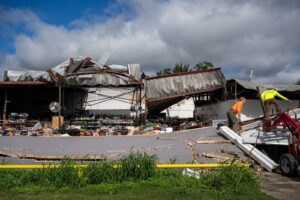Retired Maj. Gen. William Anders, the former Apollo 8 astronaut who took the iconic Earthrise photo showing the planet as a blue marble from space in 1968, died Friday when the plane he was piloting alone plunged into the waters of the San Juan Islands. Washington state. He was 90.
“The family is devastated,” said his son, Greg Anders, who confirmed the death to the Associated Press. “He was a wonderful pilot and we will miss him terribly.”
Anders said that the photo was his most important contribution to the space program, given the ecological philosophical impact it had, along with making sure the Apollo 8 Command Module and Service Module were working.
A report came in about 11:40 a.m. that an older model plane had crashed into the water and sunk near the north end of Jones Island, San Juan County Sheriff Eric Peter said.
Only the pilot was aboard the Beech A45 plane at the time, according to the Federal Aviation Association.
William Anders said in 1997 Nasa oral history interview that he did not think the Apollo 8 mission was risk-free, but there were important national, patriotic, and exploratory reasons to continue. He estimated that there was about a one in three chance that the crew would not return and the same chance that the mission would be a success and the same chance that the mission would not start. He said he suspected Christopher Columbus faced worse odds.
Anders once had recounted the experience as part of a BBC documentary about the mission. He remembered how the earth seemed fragile and seemingly physically insignificant, yet home.
After two or three orbits around the moon, he and the crew began taking pictures.
“We went backwards and upside down, didn’t really see the Earth or the Sun, and then we rolled over and came around and saw the first Earth rise,” he said. “It was certainly by far the most impressive thing. To see this very delicate, colorful orb that looked like a Christmas tree decoration to me, rising over this very stark, ugly lunar landscape, had a great contrast.”
“I don’t know who said it, maybe all of us said, ‘Oh my God. Look at it!’” Anders said.
“And the earth came up. We had no discussion on the ground, no briefing, no instructions on what to do. I jokingly said, ‘Well, it’s not on the flight plan,’ and the other two guys yelled at me to give them cameras. I had the only color camera with a long lens. So I transferred a black and white to Borman. I don’t remember what Lovell got. They were all shouting for cameras and we started snapping away.”
The photograph of the exciting swirl of life that is Earth against a background of black space and a foreground of dull, lifeless lunar landscape has become an icon of space travel and the defining image of our living world and its fragility.
The National Transportation Safety Board and FAA are investigating the crash.
Associated Press reported




